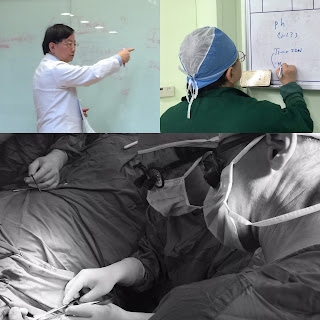Earlier this year, we published a paper in the Journal of Hand Surgery that systematically evaluated and thematically analyzed the content of 2 discussion boards for brachial plexus injury (BPI). I wanted to write a little bit here about the origin of the study, as well as some of the follow-up that will result from the study.
One of my earlier research interests during residency was trying to understand the quality and readability of information on the internet for hand surgery conditions. As a doctor, I know that my patients are often looking up information about their conditions on the internet - either trying to get a diagnose or get more information about the treatment (I do the same when I am a patient!)
I know that it can be frustrating to look for good quality information on the internet, even for common conditions. I imagine that it can be really challenging for patients newly diagnosed with brachial plexus injuries (and their families) to find reliable information. Many patients encounter discussion boards (such as the American UBPN.org and the UK's Traumatic BPI group) that have a remarkable amount of information. Anticipating that many patients and families would spend time on these websites consuming information and sharing their experience with others, we thought it would be helpful to systematically examine these websites. Basically, we wanted to see what our patients would be interested in learning and what type of information is being shared on these sites.
Marie Morris (at the time, a Wash U medical student and now one of our orthopedic surgery residents) pulled posts from UBPN.org and the Traumatic BPI discussion boards from the 2015 calendar year. Using established methods for thematic analysis and qualitative research, Marie and I then looked through each post to determine common themes. Here are the themes we came up with:
This was an incredibly educational experience for me - as a BPI surgeon, reading through all of these posts and culling them together gave me a deeper understanding of what my patients are experiencing and what they are reading. This knowledge has helped me empathize with patients and try to explain the injury and treatments in a relatable and understandable manner.
So what now? One of the secondary goals of this project was to develop a list of subjects/topics that I can write about for this blog. In the coming weeks and months, I hope to go through these themes in blog posts. The content that we found on these discussion boards was largely high quality and understandable (kudos to UBPN and Traumatic BPI!), so I hope that providing some content from the BPI surgeon perspective will be helpful to patients and families worldwide.
Christopher J. Dy, MD MPH
My Bio at Washington University Orthopedics
dyc@wudosis.wustl.edu
This post is the first in a long time! I have an early New Year's resolution to write/blog more, so no better time to start than now...
When I joined the faculty at Washington University School of Medicine, I was fortunate enough to receive a commitment from the Department of Orthopaedic Surgery to support international travel to centers of excellence in brachial plexus and peripheral nerve surgery. Without a doubt, one of the first places that came to mind for a visit was Chang Gung Memorial Hospital in Taiwan. Chang Gung Memorial Hospital (CGMH)'s reputation as a center of excellence for microsurgery is known throughout the world. I specifically wanted to learn from Professor David Chuang, an internationally-renowned expert in brachial plexus reconstruction. Professor Chuang has completed more than 2500 brachial plexus reconstructions in his career, has published over 100 papers and chapters, and continues to show an impressive eagerness to advance the practice of nerve surgery.
With support from my family and my partners, I embarked on a trip half-way around the world to Taipei. After a couple of days to adjust to the time difference, I began working with Professor Chuang and his team of junior faculty, fellows, and residents. I was welcomed warmly and immediately integrated into the team. During my 2 weeks at CGMH, I spent time with the team in the clinic and in the operating room. In the clinic, I was able to see the short-term and long-term results of Professor Chuang's brachial plexus reconstructions, which are without a doubt very impressive. In the operating room, I observed Professor Chuang and his team perform a number of brachial plexus explorations and reconstructions, using strategies and techniques perfected over a 30+ year career in microsurgery. I greatly enjoyed my conversations with him about his preoperative planning, intraoperative decision-making, and specific surgical techniques (many of which he has developed and disseminated to microsurgeons across the world). There is nothing quite like learning the "Tips and Tricks" directly from a master surgeon!


In many ways, the trip felt short - but even in this brief time, I learned an incredible amount that I will bring back to my practice and my patients at Washington University in St. Louis. I am tremendously grateful to Professor Chuang and his team at CGMH, as well as to my family and department for supporting my trip. I return to St. Louis brimming with excitement from an intellectual perspective (and probably a couple pounds heavier...)
I am excited to share (and apply) this knowledge with my partners, our trainees, and our patients. I am hopeful that all future trips will be as beneficial as my trip to CGMH in Taiwan!
Christopher J. Dy, MD MPH
My Bio at Washington University Orthopedics
dyc@wudosis.wustl.edu



